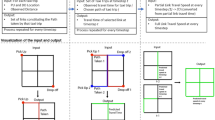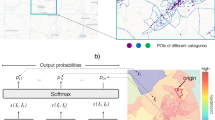Abstract
Commuting flow prediction is a crucial issue for transport optimization and urban planning. However, the two existing types of solutions have inherent flaws. One is traditional models, such as the gravity model and radiation model. These models rely on fixed and simple mathematical formulas derived from physics, and ignore rich geographic semantics, which makes them difficult to model complex human mobility patterns. The other is the machine learning models, most of which simply leverage the features of Origin-Destination (OD), ignoring the topological nature of the interaction network and the spatial correlation brought by the nearby areas. In this paper, we propose a ‘preprocessing-encoder-decoder’ hybrid learning model, which can make full use of geographic semantic information and spatial neighborhood effects, thereby significantly improving the prediction performance. Specifically, in the preprocessing part, we divide the study area into grids, and then incorporates features such as location, population, and land use types. The second step of the encoder designs a convolutional neural network (CNN) to achieve the fusion of neighborhood features, constructs a spatial interaction network with the grids as nodes and the flows as edges, and then uses the graph convolutional network (GCN) to extract the embeddings of the nodes. In the last step of the decoder, a random forest regressor is trained to predict the commuting flow based on the learned embedding vectors. An empirical study on a commuter dataset in Beijing shows that our proposed model is approximately 20% better than XGBoost (state-of-the-art), thus proving its effectiveness.







Similar content being viewed by others
Data availability
The commuting flow data is provided by Amap company, and they have not given their permission for researchers to share their data. Data requests can be made to Amap company (https://lbs.amap.com/). The land use data is publicly available online at http://data.ess.tsinghua.edu.cn/.
References
Liu Y, Liu X, Gao S, Gong L, Kang C, Zhi Y, Chi G, Shi L (2015) Social sensing: A new approach to understanding our socioeconomic environments. Ann Assoc Am Geogr 105(3):512–530
Walmsley DJ, Lewis GJ (2014) People and environment: Behavioural approaches in human geography. Routledge
Hu Y (2017) Geospatial semantics. arXiv:1707.03550
Huang W, Li S (2016) Understanding human activity patterns based on space-time-semantics. ISPRS J Photogramm Remote Sens 121:1–10
Liu X, Kang C, Gong L, Liu Y (2016) Incorporating spatial interaction patterns in classifying and understanding urban land use. Int J Geogr Inf Sci 30(2):334–350
Simini F, Barlacchi G, Luca M, Pappalardo L (2021) A deep gravity model for mobility flows generation. Nat Commun 12(1):1–13
Tardy C, Falquet G, Moccozet L (2016) Semantic enrichment of places with vgi sources: a knowledge based approach. In: Proceedings of the 10th workshop on geographic information retrieval, pp 1–2
Van Acker V, Witlox F (2011) Commuting trips within tours: how is commuting related to land use? Transportation 38(3):465–486
Wu L, Yang L, Huang Z, Wang Y, Chai Y, Peng X, Liu Y (2019) Inferring demographics from human trajectories and geographical context. Comput Environ Urban Syst 77:101368
Li Y, Yu R, Shahabi C, Liu Y (2018b) Diffusion convolutional recurrent neural network: Data-driven traffic forecasting. In: International conference on learning representations
Yu B, Yin H, Zhu Z (2018) Spatio-temporal graph convolutional networks: a deep learning framework for traffic forecasting. In: Proceedings of the 27th international joint conference on artificial intelligence, pp 3634–3640
Zhang Y, Cheng T, Ren Y, Xie K (2020) A novel residual graph convolution deep learning model for short-term network-based traffic forecasting. Int J Geogr Inf Sci 34(5):969–995
Zhao L, Song Y, Zhang C, Liu Y, Wang P, Lin T, Deng M, Li H (2019) T-gcn: A temporal graph convolutional network for traffic prediction. IEEE Trans Intell Transp Syst 21(9):3848–3858
Barbosa H, Barthelemy M, Ghoshal G, James CR, Lenormand M, Louail T, Menezes R, Ramasco JJ, Simini F, Tomasini M (2018) Human mobility: Models and applications. Phys Rep 734:1–74
Lenormand M, Bassolas A, Ramasco JJ (2016) Systematic comparison of trip distribution laws and models. J Transp Geogr 51:158–169
Masucci AP, Serras J, Johansson A, Batty M (2013) Gravity versus radiation models: On the importance of scale and heterogeneity in commuting flows. Phys Rev E 88(2):022812
Zipf GK (1946) The p 1 p 2/d hypothesis: on the intercity movement of persons. Am Sociol Rev 11(6):677–686
Ren Y, Ercsey-Ravasz M, Wang P, González MC, Toroczkai Z (2014) Predicting commuter flows in spatial networks using a radiation model based on temporal ranges. Nat Commun 5(1):1–9
Simini F, González MC, Maritan A, Barabási A-L (2012) A universal model for mobility and migration patterns. Nature 484(7392):96–100
Jordan MI, Mitchell TM (2015) Machine learning: Trends, perspectives, and prospects. Science 349(6245):255–260
Morton A, Piburn J, Nagle N (2018) Need a boost? a comparison of traditional commuting models with the xgboost model for predicting commuting flows (short paper). In: 10th International Conference on Geographic Information Science (GIScience 2018). Schloss Dagstuhl-Leibniz-Zentrum fuer Informatik
Mozolin M, Thill J.-C., Usery EL (2000) Trip distribution forecasting with multilayer perceptron neural networks: A critical evaluation. Transp Res B Methodol 34(1):53–73
Pourebrahim N, Sultana S, Niakanlahiji A, Thill J-C (2019) Trip distribution modeling with twitter data. Comput Environ Urban Syst 77:101354
Tobler WR (1970) A computer movie simulating urban growth in the detroit region. Econ Geogr 46(sup1):234–240
Xing X, Huang Z, Cheng X, Zhu D, Kang C, Zhang F, Liu Y (2020) Mapping human activity volumes through remote sensing imagery. IEEE J Sel Top Appl Earth Obs Remote Sens 13:5652–5668
Stouffer SA (1940) Intervening opportunities: a theory relating mobility and distance. Am Sociol Rev 5(6):845–867
McArthur DP, Kleppe G, Thorsen I, Ubøe J (2011) The spatial transferability of parameters in a gravity model of commuting flows. J Transp Geogr 19 (4):596–605
Black WR (1995) Spatial interaction modeling using artificial neural networks. J Transp Geogr 3(3):159–166
Spadon G, de Carvalho AC, Rodrigues-Jr JF, Alves LG (2019) Reconstructing commuters network using machine learning and urban indicators. Sci Rep 9(1):1–13
Liu Z, Miranda F, Xiong W, Yang J, Wang Q, Silva C (2020) Learning geo-contextual embeddings for commuting flow prediction. In: Proceedings of the AAAI conference on artificial intelligence, vol 34, pp 808–816
Yao X, Gao Y, Zhu D, Manley E, Wang J, Liu Y (2020) Spatial origin-destination flow imputation using graph convolutional networks. IEEE Trans Intell Transp Syst
Ullman EL, Boyce RR (1980) Geography as spatial interaction. University of Washington Press
Defferrard M, Bresson X, Vandergheynst P (2016) Convolutional neural networks on graphs with fast localized spectral filtering. In: Proceedings of the 30th international conference on neural information processing systems, pp 3844–3852
Kipf TN, Welling M (2017) Semi-supervised classification with graph convolutional networks. In: International Conference on Learning Representations (ICLR)
Wang Y, Zhu D, Yin G, Huang Z, Liu Y (2020) A unified spatial multigraph analysis for public transport performance. Sci Rep 10:9573–9581
Wu Z, Pan S, Chen F, Long G, Zhang C, Philip SY (2020) A comprehensive survey on graph neural networks. IEEE Trans Neural Netw Learn Syst 32(1):4–24
Miller HJ (2004) Tobler’s first law and spatial analysis. Ann Assoc Am Geogr 94(2):284–289
Hirschman II, Widder DV (2012) The convolution transform. Courier Corporation
LeCun Y, Bottou L, Bengio Y, Haffner P (1998) Gradient-based learning applied to document recognition. Proc IEEE 86(11):2278–2324
Hubel DH, Wiesel TN (1962) Receptive fields, binocular interaction and functional architecture in the cat’s visual cortex. J Physiol 160(1):106–154
Gong P, Chen B, Li X, Liu H, Wang J, Bai Y, Chen J, Chen X, Fang L, Feng S, et al. (2020) Mapping essential urban land use categories in China (euluc-china): Preliminary results for 2018. Sci Bull 65(3):182–187
Zhu D, Zhang F, Wang S, Wang Y, Cheng X, Huang Z, Liu Y (2020) Understanding place characteristics in geographic contexts through graph convolutional neural networks. Ann Am Assoc Geogr 110(2):408–420
Breiman L (2001) Random forests. Mach Learn 45(1):5–32
Chen T, Guestrin C (2016) Xgboost: A scalable tree boosting system. In: Proceedings of the 22nd acm sigkdd international conference on knowledge discovery and data mining, pp 785–794
Grover A, Leskovec J (2016) node2vec: Scalable feature learning for networks. In: Proceedings of the 22nd ACM SIGKDD international conference on Knowledge discovery and data mining, pp 855–864
Mikolov T, Sutskever I, Chen K, Corrado GS, Dean J (2013) Distributed representations of words and phrases and their compositionality. In: Advances in neural information processing systems, pp 3111–3119
Perozzi B, Al-Rfou R, Skiena S (2014) Deepwalk: Online learning of social representations. In: Proceedings of the 20th ACM SIGKDD international conference on Knowledge discovery and data mining, pp 701–710
Goodfellow I, Bengio Y, Courville A (2016) Deep learning. MIT Press
Li Q, Han Z, Wu X.-M. (2018a) Deeper insights into graph convolutional networks for semi-supervised learning. In: Proceedings of the AAAI conference on artificial intelligence, vol 32
Jenks GF (1967) The data model concept in statistical mapping. Int Yearb Cartogr 7:186–190
Acknowledgements
We thank the editors and reviewers for their suggestions to improve the quality of this paper. This research was supported by grants from the National Natural Science Foundation of China (41830645, 41971331).
Author information
Authors and Affiliations
Corresponding author
Ethics declarations
Conflict of interests
The authors declare that they have no known competing financial interests or personal relationships that could have appeared to influence the work reported in this paper.
Additional information
Publisher’s note
Springer Nature remains neutral with regard to jurisdictional claims in published maps and institutional affiliations.
Rights and permissions
About this article
Cite this article
Yin, G., Huang, Z., Bao, Y. et al. ConvGCN-RF: A hybrid learning model for commuting flow prediction considering geographical semantics and neighborhood effects. Geoinformatica 27, 137–157 (2023). https://doi.org/10.1007/s10707-022-00467-0
Received:
Revised:
Accepted:
Published:
Issue Date:
DOI: https://doi.org/10.1007/s10707-022-00467-0




